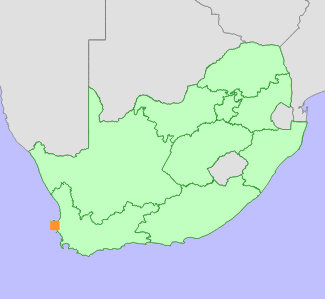|
Scientific Name | Aloe distans Haw. |
Higher Classification | Monocotyledons |
Family | ASPHODELACEAE |
Common Names | Strandaalwyn (a) |
National Status |
Status and Criteria | Vulnerable B1ab(i,ii,iii,iv,v)+2ab(i,ii,iii,iv,v) |
Assessment Date | 2018/11/15 |
Assessor(s) | H. Mtshali |
Justification | Aloe distans has a restricted distribution (EOO 499 km²). It is known from eight to ten locations, and is declining due to ongoing habitat loss and degradation. |
Distribution |
Endemism | South African endemic |
Provincial distribution | Western Cape |
Range | Aloe distans is restricted to the West Coast of the Western Cape Province, South Africa, occurring between St Helena Bay and Saldanha Bay. |
Habitat and Ecology |
Major system | Terrestrial |
Major habitats | Saldanha Granite Strandveld, Langebaan Dune Strandveld, Saldanha Limestone Strandveld |
Description | It occurs on granite outcrops along the coast. |
Threats |
| Aloe distans is threatened by habitat loss to coastal development, particularly on the Vredenburg Peninsula and around Langebaan. Further inland around Vredenburg and Darling, more than 70% of granite strandveld and renosterveld has been converted to crop fields, but this species' preference for rocky outcrops may have provided some protection against ploughing. Field observations by Custodians of Rare and Endangered Wildflowers (CREW) Programme however noted overgrazing as an ongoing threat of small renosterveld fragments near Darling. Around Jacobsbaai, spreading informal settlements and overgrazing by livestock is also causing ongoing habitat degradation. |
Population |
Aloe distans is locally abundant in suitable habitat. It is currently known from seven subpopulations, but it is possible that more exist as it was only recently reinstated after long being considered a synonym of Aloe perfoliata (now A. mitriformis). A continuing population decline is inferred from ongoing habitat loss and degradation.
|
Population trend | Decreasing |
Assessment History |
Taxon assessed |
Status and Criteria |
Citation/Red List version | | Aloe distans Haw. | EN B1B2e | Victor (2002) | | Aloe distans Haw. | Rare | Hilton-Taylor (1996) | | Aloe distans Haw. | Rare | Hall et al. (1980) | |
Bibliography |
Hall, A.V., De Winter, M., De Winter, B. and Van Oosterhout, S.A.M. 1980. Threatened plants of southern Africa. South African National Scienctific Programmes Report 45. CSIR, Pretoria.
Hilton-Taylor, C. 1996. Red Data List of southern African plants. 1. Corrections and additions. Bothalia 26(2):177-182.
Manning, J.C. and Goldblatt, P. 2012. Plants of the Greater Cape Floristic Region 1: The Core Cape Flora. Strelitzia 29. South African National Biodiversity Institute, Pretoria.
Smith, G.F., Steyn, E.M.A., Victor, J.E., Crouch, N.R., Golding, J.S. and Hilton-Taylor, C. 2000. Aloaceae: The conservation status of Aloe in South Africa: an updated synopsis. Bothalia 30(2):206-211.
Van Wyk, B.-E. and Smith, G.F. 2014. Guide to the Aloes of South Africa. (Third ed.). Briza Publications, Pretoria.
Victor, J.E. 2002. South Africa. In: J.S. Golding (ed), Southern African plant Red Data Lists. Southern African Botanical Diversity Network Report 14 (pp. 93-120), SABONET, Pretoria.
|
Citation |
| Mtshali, H. 2018. Aloe distans Haw. National Assessment: Red List of South African Plants version . Accessed on 2025/05/09 |
 Comment on this assessment
Comment on this assessment

